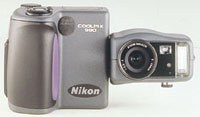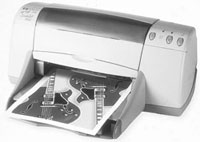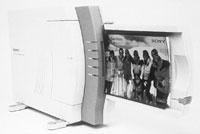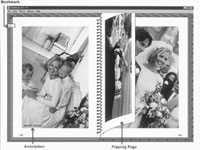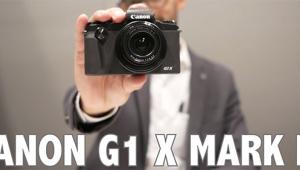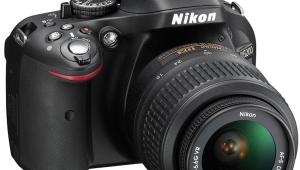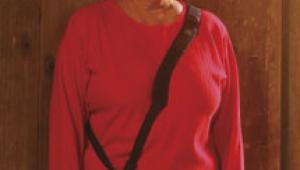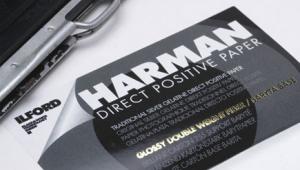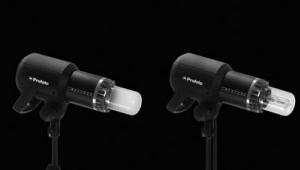A Personal Look At Digital Imaging
While the annual PMA show is rooted in traditional photography, digital technology is becoming more and more a part of the event. So much so that it was a challenge to see everything that might be considered digital at the show, but I tried. Any omissions are purely unintentional, and anything I might have missed will show up later in one of my Digital Innovations columns. Digicams On Parade. The buzz about digital cameras at PMA was about the next breakthrough in pixelmania. Cameras with three plus megapixels were introduced by Casio, Canon, Fuji, JVC, Nikon, Olympus, and Sony delivering the best pixel per pennies value around. |
|
It wasn't all 3Mp cameras at the show. PMA 2000 was the first time I finally got my hands on Agfa's ePhoto CL30 Clik!, which is the first digital camera to use a built-in Iomega Clik! drive. With the price of these little 40MB disks under $10, I think this form of "digital film" is sure to catch on. The camera had a nice "feel" with controls located right where you would want them to be. With image resolution of 1158x876, the use of inexpensive, high capacity media, and a price tag of $549 (plus a $50 mail-in rebate), I expect the ePhoto CL30 Clik! will find an audience. While the company is probably getting sick of seeing this in print, my first 35mm camera was an Argus C3, which became part of a rite of passage for many photographers of my generation. Now the company is part of the digital age and announced a $199 megapixel camera at the PMA show. The DC3000 Mega-Pixel Digital Camera features one million pixel output resolution using a Sony high-resolution CCD Sensor, dual focus switchable lens, electronic flash, LCD multifunction display, 24-bit color, and uses SmartMedia cards for image storage. The DC3000 is compatible with Windows '95 and '98 as well as NT operating systems. Casio, the people who made the LCD preview panel der rigueur for every digital camera, introduced its QV-3000EX digicam with 3.34Mp imager. The camera has great ergonomics and sports some interesting specifications. Image storage is through an 8MB CompactFlash (CF) card or optional 340MB IBM Microdrive that uses the CF card form factor. The Microdrive can store 245 images at the camera's 2048x1536 maximum resolution or 943 images at 1024x768 pixels, as well as 10 sec of AVI video. The 8MB CF card can hold five images at maximum resolution and 15 at 1024x768 pixels. The lens is an f/2.0 Canon 3x optical zoom. The QV-3000EX uses a Universal Serial Bus (USB) computer connection. Casio also showed their new WQV-1 wrist watch camera and wrist watch MP3 music player. Better Light, a company that makes digital scanning inserts for view cameras, introduced two new models that offer greater resolution than their current product line. The new Super 6K model records up to 309MB 24-bit files at 9000x12,000 pixels. Better Light's Super 8K model provides 8000x10,660 resolution files at 244MB at its 100 percent resolution setting which can be increased up to a maximum of 12,000x15,990 at 549MB. Both Super Model inserts can capture 48-bit RGB files that are twice the size of 24-bit files and offer a selection of resolution settings providing users with the ability to produce a file that matches the needs of the final output device. |
|
JVC introduced their new 3.3Mp GC-QX3 camera at the show. It features a 2.3 optical zoom glass aspherical lens, along with a 7:1 digital zoom. Resolution is 2032x1526 with smaller sized options available for less resolution critical applications, such as the web. Four ISO equivalent sensitivity settings are available, including 80, 200, 400, and 800. The camera uses a multiple exposure, stacking technique that stacks images on top of one another to eliminate noise and raise the signal to noise ratio. In Pro-Still mode, two exposure levels (one bright, one dark) are stacked to accurately reproduce all areas of the picture. Those readers who have worked with contrast masking in the traditional darkroom will understand this concept. The GC-QX3 uses SmartMedia for image storage and files are transferred from camera to computer via a USB connection. Discussed with me unofficially and officially announced just after the show, Kodak's PalmPix camera adds image capture capability to the 3Com Palm Pilot. The camera includes a fixed focus lens, 2x digital zoom, and self-timer. Pictures can be viewed on the Palm Pilot's 2.3x2.3" LCD screen as a gray scale image, then transferred to your desktop computer through the Palm Pilot's HotSynch cradle. Each file is about 100K in size and, until transferred to a computer, is stored in the Palm organizer. Once on the computer desktop, the pictures are stored as standard JPEG or bitmap files. PalmPix is compatible with Palm III, IIIe, and IIIx; IBM WorkPad; Palm VII platform; and TRG Pro. The Kodak PalmPix camera will be available for $179, along with PalmPix accessories online at: www.kodak.com/go/shop in the second quarter. The first of two film-based cameras that found its way into my show coverage is Kodak's Advantix Preview Advanced Photo System (APS) camera that features a 2.6x zoom and built-in flash. What makes it worth mentioning, is the built-in 1.8" LCD screen. If the photographer likes what he or she sees on the screen, they can order extra prints by touching a button on the camera's back. If they don't like what they see, they can select "no prints." While different than Polaroid's anticipated hybrid digital/film camera (more later), the Advantix Preview points to other possibilities in combining digital and silver halide technology--especially those like APS that uses the format's Information Exchange (IX) to select the number of prints to be produced during photo-chemical processing. Largan showed three new digital point-and-shoot cameras including the Chameleon, which converts from a digital still camera into a PC camera for capturing live images used for teleconferencing and other Internet-related visual communications. A combination of 640x480 resolution and close focusing--just under 2'--make it ideal as a monitor-top camera. With its flash built into a pop-up lens cover, The Largan Digital sports a body shape reminiscent of some Kodak APS Advantix cameras. That along with its modest 640x480 resolution and fixed focus f/4 lens make it well suited for making digital snapshots. The Easy 800 offers 1024x768 image resolution and the 35mm equivalent of a 32mm fixed focal length lens. Images are stored on CompactFlash media and can be downloaded directly from the camera's serial port or Largan's optional CompactFlash card reader. |
|
One of the major players in the 3Mp shootout is Nikon with their 3.34Mp CoolPix 990 model which is priced just under $1000. With an image resolution of 2048x1536 along with a file size of 10MB, you can tell this is a camera designed for the serious pixographer. In addition, you can capture 80 frames of video at a real-time rate of 30 frames per second (fps). Lens is a 3x Zoom Nikkor with a 35mm equivalent of 38-115 and a digital zoom with up to 4x. In addition, you can add a 2x tele-converter to provide the equivalent of 920mm telephoto performance. This magnesium chassis camera sports styling cues from recent CoolPix models, including a rotating, swiveling lens and has a USB interface for faster image downloads. A multi-synch terminal connects to an external SB-28D or other Nikon flash unit. |
|
Olympus announced several new cameras at the show, including the D-360L digital point-and-shoot camera, which is based on its entry-level D-340R model. Priced at $299, the 1.3Mp D-360L includes five resolution options ranging from 640x480 up to an uncompressed TIFF file of 1280x960 pixels. Their new D-460 Zoom is a stylish champagne gold metallic point-and-shoot camera with 1.3Mp resolution (1280x960) and is priced at $499. Olympus also announced their C-2020 Zoom 2.11Mp camera with 1600x1200 pixel resolution, a 3x optical zoom lens, and infrared remote. The C-2020 Zoom is the first Olympus camera to offer black and white and sepia modes for shooting black and white images. In its Blackboard/Whiteboard Mode, the appropriate exposure settings are automatically selected for capturing text and ensuring clear, visible writing in the images. The company's new C-3030 Zoom is a 3.34Mp--2048x1536 resolution--digital camera offering USB and serial connectivity. The all-glass 3x zoom lens provides a 35mm equivalent of 32-96mm and includes 2.5x digital telephoto capability. The camera lets you select from 15 resolution options, including five uncompressed TIFF modes. The camera even offers QuickTime movie capability with sound. Street price of the C-3030 is under $1000. While Panasonic reshuffles its digicam line-up, its only camera is the SuperDisk powered PalmCam PV-SD4090, that bears more than a passing resemblance to a Mamiya medium format rangefinder. The SuperDisk drive has a 120MB capacity that enables the camera to store up to 1500 images in Standard Resolution (640x480 pixels). At High Resolution, (1280x960 pixels), the disk holds approximately 450 Super Fine images or 900 Fine images. The camera is also compatible with 1.44MB disks and will hold five Super Fine, 10 Fine, or 17 High-Resolution images on a traditional floppy disk. What's interesting about the camera is that with its built-in USB connection, you can use it as an external floppy or Super Disk drive. What impressed me next was the strikingly designed computer that the Panasonic digicam was connected to. Much like an iMac in that it was basically a box and keyboard, the "Will" uses a LCD screen giving it a smaller bulk than an Apple's offering along with a compact keyboard that has a much better feel than the Apple's. The Will is part of a family of co-branded Japanese products that includes different companies, including Toyota. While the Panasonic representative that I spoke with didn't know when--or even if--the Will computer will be sold in America, I want to be the first kid on my block to own one. Resolution Technology introduced a 4x5" view camera adapter for Phase One's LightPhase digital camera back. The LP48 adapter allows the LightPhase to create 48MB image files by stitching three LightPhase images together (48MB in RGB 8 bit per channel or 96MB in RGB 16 bit per channel). The final image can measure up to 5300x3000 pixels and the active capture area is up to 36x63mm. The 5300x3000 pixels can be captured in landscape and portrait orientation. |
|
During our "live" coverage of the show at shutterbug.net, my product of choice for Day One was not a digital product at all, but it does produce instant results. Polaroid's iZone camera decked out in Looney Tunes cartoon characters brought a smile to my face. Later this year, Polaroid promises to deliver a hybrid digital/analog model of the standard iZone--no cartoon characters--for under $100. Yup, for under a $100 you can make one of the tiny (1x1.5") iZone prints as well as store digital files using some form of e-film media. Polaroid also introduced a family of Windows-based PhotoMax Fun! cameras for $59.95 that produce 320x240 pixel resolution images. If you need more quality, the PDC 1100 delivers 1152x864 images for $299. Just before PMA, Polaroid announced its iZone Pocket Scanner, a mouse-sized scanner that lets you digitize iZone prints or any other small image. Can you say stamp collector? On the higher end of the scanner market, Polaroid's new SprintScan 45 Ultra Multi-Format film scanner accepts 35mm slides, medium format film (6x6 and 6x7), along with 4x5 sheets. Priced at just under $10,000, the new SprintScan has an optical density of 3.9, and captures 42 bits per channel. |
|
Samsung Opto-Electronics America launched four new--almost tiny--digital cameras at the show. The Cybermax 35MP3 is not just a cool looking digital camera but a capable MP3 music player as well. The camera features 640x480 resolution, 2MB of built-in memory, and uses CompactFlash cards for image storage. The 35MP3 costs $289.99 and sports an optical viewfinder, and serial port connectivity. The Cybermax 35 has all of the specifications of the previously mentioned model except for music download capability. Up in price and resolution is the Digimax 130Z which captures 1280x960 images and stores them on the bundled 8MB CompactFlash card. The camera offers images at 1280x960 pixels and displays them on a 1.8" LCD preview screen. An optical viewfinder is also standard along with a 3x zoom lens. In a flash of inspirational multifunctionality, the under $600 Digimax 130Z can be tethered to your computer and act like one of the monitor-perched video cameras used for teleconferencing. At the top of the pyramid is the $1019.99 Digimax 210SE sporting a genuine Schneider-Kreuznach zoom lens and 1600x1200 image quality. Silicon Film Technologies has shown in and around the PMA show in recent years, now they were seriously in the fray showing their Electronic Film System. Looking much like an electronic 126 film cartridge their (e)film cartridge uses a high-resolution Complimentary Metal Oxide Semiconductor (CMOS) image sensor (1280x1024 pixels) as part of a self-contained electronic film system that captures and stores digital images. Other parts of the system include the (e)port Carrier, a multipurpose carrier for the (e)film cartridge which provides a protective housing as well as a source to link it to a laptop computer or Silicon Film's own (e)box storage module. The (e)port Carrier's main function is to serve as a download device for (e)film and supports PC Card Type II and USB connections. The (e)box Storage is an image storage device designed for use in the field and accepts fast download of pictures from the (e)port so it frees the photographer to reuse the (e)film electronic film cartridge to capture more images. The (e)box supports CompactFlash Type I and II storage media and allows fast storage of digital images without a computer. Sony introduced six new digital cameras including three new Digital Mavica models. The FD95 is a 2.1Mp camera with a 10x optical zoom and a price tag of $1000. The new FD85 and 90 cost $700 and $800 respectively and produce 1.3 and 1.6Mp resolution images. All new Digital Mavica cameras offer a 3:2 image aspect ratio that matches that of a 4x6" print. The FD 90 and 95 have external flash synchronization with Sony's new HVL-F1000 optional flash. Sony also introduced three new Cyber-shot cameras sporting Carl Zeiss lenses and despite what appears to be ungainly styling proved to surprisingly ergonomic. The new line of Cyber-shot cameras includes the 3.3Mp DSC-S70 and the S50 and S30 models priced at $800, $600, and $500 respectively. The S50 and S30 models deliver 1.6 and 2.1Mp resolution and, like all Cyber-shots, use Memory Stick storage media. Sony also announced a Memory Stick USB adapter that will transfer data from the cards to any USB equipped Macintosh or Windows computer at 3MB per sec. The S70 model accepts the new Sony HVL-F1000 external electronic flash which is priced at $120. The new Cyber-shots are capable of capturing images with a user-selectable 4:3 or 3:2 aspect ratio, making it useful with the new Sony photo printer mentioned later in this article. |
|
Digital Film And Accessories. Call it digital film or e-film or whatever, there are now five viable formats available, and at PMA there was news about many of them including other accessories that make creating digital images easier. Delkin Devices announced it had started shipping its new 242MB CompactFlash card. The eFilm 224MB is compliant with all CompactFlash Association's (www.compactflash.org) specifications and all Type II Compact Flash devices. They also introduced a 64MB SmartMedia card. Inside all CompactFlash and SmartMedia packages is a CD-ROM containing digital imaging programs such as ixla's Digital Camera Suite, Explorer, and Web Easy. Also included is Piccolo, a program that automatically recognized your digital camera and knows where the images are stored on the e-film card. The company introduced two new USB card reader/writers: Reader-2 for CompactFlash and Reader-4 for SmartMedia cards up to 128MB. Digital cameras eat batteries, right? While I didn't get to meet the Energizer Bunny I did get to meet an Eveready engineer who introduced me to the company's new e2 lithium batteries designed for digital cameras and other high-demand photo applications. Energizer e2 batteries use a proprietary technology that combines a titanium compound along with a new type of cell construction to provide 35 percent longer life that the familiar "Pink Bunny" Energizers. Hakuba offers a wide range of useful and practical accessories for digicams from great looking cases and pouches to its PowerPen cleaning tool for removing oxidation and corrosion from batteries. One of their most useful accessories, the Batt Pak, provides space for an extra SmartMedia, CompactFlash, or Memory Stick (or two) and four AA or two 9v sized camera batteries. All this is wrapped up in a small, zippered pouch that also has a clip that allows you to hook it to a camera bag or your belt loop. If you've ever lost or misplaced a digital film card, you know that it's a lot easier to do than most of us would like to admit. Get yourself a Batt Pak, so you know where your batteries or e-film is stored. Lexar Media announced new digital film media designed specifically for professional photographers. This includes a 512MB PC card and a 256MB USB enabled Type II (5mm) CompactFlash card. The new card is nearly 35 percent larger than Lexar's current 320MB PC Card, and the card's 8x write speed reduces wait time and minimizes the chance of missing a spontaneous shot. At the show, Lexar also introduced a new 64MB SmartMedia card. Microtech International showed a device that every digital camera owner is going to love. The PCD-47B (who thinks up these names anyway?) is a three-slot digital film reader that accepts PC Cards, SmartMedia, and CompactFlash storage media. There are two models available: one is a 31/2" internal device that's obviously designed for use in Windows environments. The other is an external unit that utilizes the sleek round cornered design common to most of Microtech's peripherals. Price of the external unit is expected to be under $400, but before you choke on that, let me remind you that it uses a SCSI interface for the fastest image downloads this side of FireWire. Users of other kinds of media, such as Sony's Memory Stick can use them in a PC Card adapter. SanDisk introduced a new generation of flash memory technology that increases the size of its digital camera storage media. Using this new technology, SanDisk's top capacity of Type 1 (2.5mm) CompactFlash cards increases to 192MB and Type II CompactFlash cards goes to 300MB. Similar increases occurred in other formats with Type II PC cards increasing to 1.2GBV. At the show, SanDisk introduced a Type III (10.5mm) PC Card with a capacity of 1.6MB. While all three new Sony Digital Mavica models still accept floppy disk media, Sony announced a Memory Stick adapter that attempts to do what FlashPath does for SmartMedia by allowing the media to be used in a standard floppy disk drive. By using the adapter inside any of the new FD models, users can have access to greater capacity through the availability of the newest 64MB Memory Sticks. After the show, I tried it with some images shot on Memory Stick at the show and operation was seamless and easy to use. |
|
Printers And Printing. The first thing that 80 percent of all digicam owners want to do is print their images and PMA 2000 offered something for everyone. With 40 million ink jet printers shipped by various manufacturers during 1999, these kinds of photo printers are clearly popular with professional and amateur photographers alike. Epson introduced three new printers at PMA; The Stylus Photo is the latest model in their line of photo-realistic ink jet printers. Priced at $299, the printer prints up to letter-sized images at 1440x720dpi using a small picoliter ink droplet. For those of you who were measuring, this is 33 percent smaller than the droplet size found in the impressive Stylus Photo 750. The slightly more expensive, $399 Stylus Photo 875DC (Digital Camera) has similar reproduction capabilities but has a built-in PC card reader that accepts any kind of digital film media that fits a PC Card adapter, which includes CompactFlash, SmartMedia, or Memory Stick. The larger format 1270 has the ability to print images up to 13x19." Interestingly, the new models are quieter and print 40 percent faster than previous Stylus Photo models. All of the new Stylus Photo printers include parallel and USB ports to work with Mac OS or Windows computers. They also have the ability to print 4x6" images on the new 4" rolls of Epson Photo Paper which attach to the printer with an adapter. The big news is that the new Premium Glossy and Matte Heavyweight papers are designed to work with a new ink formulation for these printers to produce an expected life of 10-20 years. You might want to check Wilhelm Imaging Research's web site (www.wilhelm-research.com) to find the latest on ink jet media longevity, including this new material from Epson. |
|
Announced just two days before PMA, Hewlett-Packard introduced two new ink jet printers, the DeskJet 950C/952C and 930C/932C. Prices of the printers are $299 and $199 respectively. In addition to a 100 sheet paper tray, the 950C/952C lets you store up to 20 sheets of HP's 4x6" snapshot paper in a separate tray. All of the new printers use five picoliter drop size and precise algorithms to place up to 29 drops per dot, providing a wide range of colors. In addition, the printers offer an "alternative photo mode" that can print images up to 2400x1200dpi on photo paper. With the 950C/952C output speed is 11 pages per minute (ppm) for black text and 8.5 ppm for color. With the 930C/932C printers output speed is 9 ppm for text and 7.5 ppm for color output. Ilford introduced the second in its line of ink jet photo papers; this one featuring a semimatte surface. Ilford's semimatte Inkjet Photo paper has a heavyweight RC base, allowing users to produce digital prints that have a "real" photographic look and feel. In addition, the semimatte paper has the same kind of fade resistant qualities that previous Ilford ink jet media offered, including a smooth surface and non-yellowing neutral base tint. The ink receiving layer has been designed to absorb the heavy ink loads that some printers use when producing photographic quality output. Kodak introduced four new ink jet photo papers that incorporate a fourth generation, multilayer, ink receptive coating on the front of the resin coated paper. The coating minimizes light scatter and has a richer, glossier look than more porous papers. The new papers include Kodak Premium Picture Paper, a high-gloss, heavyweight paper designed to provide the look and feel of traditional silver prints. Kodak Picture Paper features a double-sided soft gloss finish on a lighter weight stock and is designed to be cost effective for everyday use by families and businesses watching their expenses. Kodak Premium Inkjet Paper for Letters and Reports is coated with a matte finish and is appropriate for those projects that combine text and photograph, such as reports or flyers. Thrifty digital imagers will like the new Kodak Bright White Inkjet Paper that produces excellent quality photographic output as well as sharp text but with a price tag of $8.99 for a 500 sheet ream. |
|
Calling Sony's beautiful UP-DP10 printer a snapshot printer does it a disservice. Sure, it prints 4x6" borderless prints using dye sublimation technology including an "overcoat" that has three user selectable choices--glossy, matte, or texture--but it's a state of the art design that works in a vertical or horizontal position. In 25 print packages of ribbon and paper, media costs work out to about 60¢ a print. The printer has a USB connection for Macintosh or Windows computers and the quality standards are designed to match those produced by a minilab using silver halide technology. The UP-DP10 has a suggested list price of $389. Invasion Of The Dot Coms. If 3Mp digicams were the stars of PMA, then it was the dot coms who provided back-up support with many different booths representing sites for photo sharing, online imaging, and even online manipulation. I believe that it's the increased presence of the dot coms and digital imaging, in general, that have fueled an overall interest in imaging--silver-halide based and digital--at the PMA show and with photographers worldwide. There were so many web-oriented companies that it was impossible for me see and visit every one of them. If I missed any, I'll be sure to include them in a future Web Site of the Month column. One concern that most photographers have about having a web site or posting images on the web is the fear of theft and copyright violation. Alchemedia offers solutions via its PixSafe product for large corporations or stock photo libraries, but while the company works to bring this theft-proof technology to individual photographers, they have implemented a free web site--www.cleavercontent.com--that allows you to post a limited number of protected images. Photographers can sign up for a free online portfolio that includes a personal URL (Uniform Resource Locator), a biography, and a showcase for their protected optimal-sized images. Photo buyers can use a search engine on cleavercontent.com to locate photographers, images, or subjects by name. The word "free" always gets a photographer's attention, so when emem ories.com said they will process, scan, and upload images to the web for free I paid attention. Once you get to their web site, users who've had their film processed for free by ememories.com will be directed to a private location on the site that allows them to view their pictures and choose the ones they want to turn into prints. The company promises that users will also be able to take advantage of free, unlimited online storage. The fine prints says that, "Visitors to the emomories.com site today will find information on how to sign up for free film processing when it becomes available early next year." Caveat Webtor. ArcSoft, whose inexpensive and clever image manipulation software has often appeared in my Digital Innovations column, announced a new feature for their photo sharing site, www.photoisland.com The new PhotoWorkshop area allows you to perform image manipulations found in two of the companies stand-alone products--PhotoFantasy and PhotoEffects. Called online, iPhotoFantasy, this part of the Workshop lets pixographers place their faces on images from any source including those from their PhotoIsland album, floppy disk, CD-ROM, or hard disk. You can choose from more than 100 fantasy templates including athletes, sports card, and costumes. The iPhotoEffect area includes over 20 special effects such as oil paint, tile, sketch, and splash. You can apply and view your results in real-time. Kablink.com includes a digital camera as part of their service. You can take the Kablink-enabled camera and do a zero-click upload of images. All you have to do is plug in the USB camera and images are securely transmitted to a user's personal web space. Kablink lets you communicate with images by providing a web-based e-mailer that automatically integrates a thumbnail in the message that is as easy to use a traditional text-centric e-mail. Kablink uses LizardTech's compression technology mentioned later in this report to provide the ability to zoom into images to view greater detail. Ofoto has added several new features to its online photofinishing web site. Since digital images can be taller or wider than traditional silver prints, Ofoto members now have the option to print the entire full frame image on a standard sized sheet of photo paper instead of cropping it. You can also copy photos between existing online albums and into new albums as well as edit or delete any captions or comments. Anyone using www.ofoto.com to upload their digital pictures for the first time will receive the first 50 4x6" prints for free. After that, prints are available at affordable prices such as 49¢ for a 4x6 print, 5x7s for 99¢, and 8x10s for $2.99. PhotoPoint.com claims to be the Internet's largest free photo sharing site that as of the PMA show had five million images online. Launched in 1998, PhotoPoint provides free membership, unlimited free storage, and an easy way to post photos, as well as share images with family and friends around the globe. Casio, Zing.com, and FotoNation have joined together to allow digital camera users to upload images directly from Casio's Internet camera to the Zing web site using a built-in "click-free" technology developed by FotoNation. Current Casio digital camera users will be able to automatically upload images directly through their computer to the Zing web site using FotoNation's FotoDeveloper Uploader software. The next stage will allow consumers to bypass their computer using FotoNation's FotoCall modem and upload pictures directly to the web site. In stage three, new Internet cameras will connect directly to a phone line for upload to the Zing web site. This "click-free" technology lets digital camera users bypass all of current procedures for transferring and saving pictures onto a computer prior to transmitting them to the web. Casio digital camera owners will be able to pull images directly from their Internet cameras onto the Zing.com web site, allowing users to spend more time creating and sharing albums, selecting pictures for prints, ordering personalized photo gifts, and printing directly from the Zing.com web site onto a home printer. Software. While most of the software I saw at PMA 2000 was evolutionary--not revolutionary--in nature, there are always a few surprises lurking around the corner. Just before I walked into a room where many companies were demonstrating their products, a representative of ImageID stuck one of their round multicolored stickers on my jacket. Shortly thereafter, another person from the company photographed me with my two companions. Later that evening, while visiting with ImageID they used one of the inexpensive monitor top video cameras to scan my colored "target" and within a few milliseconds, all of the images I was photographed in appeared on their screen. Cool stuff, but what does that have to do with the average Shutterbug reader? Expect to encounter this Smart Picture technology at special events, theme parks, and even cruises. In addition to the target, you get a PIN number that lets you view the images on a web site and even place orders or reorders for the images. Those of you with X-Files-like privacy concerns should know that Smart Picture is designed to facilitate the distribution of posed photographs that are taken with the full consent of subject. |
|
Two inexpensive Windows programs from eBook Systems let you build digital albums that not only look like albums but act like them, too. The $49.95 FlipAlbum lets you design a digital scrapbook that contains photographs and text from an assortment of templates included in the package. CD Maker lets you turn that album into a presentation that can be self-running or completely interactive and write it onto a CD-R or CD-RW disc to be used by anyone, whether they have a copy of CD Maker or FlipAlbum or not. At the Enroute booth, I watched some of the most amazing video clips I've ever seen. Created with a camera system that resembles a floating mine with camera lenses sticking out all over like stubby tentacles, these multiple video images were reassembled into one moving 360 environment with Enroute's PowerStitch software. PowerStitch is the first program capable of stitching grids of images together to render a single high-resolution panoramic image. Using the software's toggle controls, you can use it to correct for lens distortion, dial in specific lens parameters, and adjust the field of view. PowerStitch can accept any number of images of any file size and output a rendered image of any size--subject only to the limitations of your own hardware. These kinds of controls allow digital photographers to turn their standard cameras into the virtual equivalents of medium or large format gear. French company Eroket who has only being doing business in the US for two months when the show opened, launched Version 4.0 of its FotoStation imaging software. While new to America, a heavy-duty commercial version of the program is widely used by newspapers and magazine publishers all over Europe. Imagine a program that costs under $200 but includes features of image management programs and image-editing programs in one easy to use package. FotoStation includes simple tools designed to let you adjust contrast and sharpen images, and color adjustments can be applied to all or part of an image and is available in both Mac OS versions. Other than its unusual name, MrSid (Multi Resolution Seamless Image Database) from LizardTech, Inc. only does one thing: compress images. It does this smoothly, seamlessly, and with less muss and fuss than any other similar product that I've tried. It's a Photoshop plug-in that lets you save photographs at 3 percent of their original size with only microscopic differences in image quality. This allows you to transmit files over the Internet or a network much faster than using the original, huge file. Even if the image is printed from the compressed file, quality remains amazingly high. As part of that function, MrSid automatically chooses the optimal resolution for the output of the device selected. The package includes some free plug-ins that allow MrSid-compressed images to be used with QuarkXPress, Adobe InDesign, and Acrobat, as well as web browsers to let you share images without the attendant pixelization that too often occurs when a thumbnail is being viewed instead of the original file. When working with photo sharing web sites, such as www.kablink.com, that integrate MrSid technology into their servers, you can view images at increasing higher magnifications--not just the one shown--to examine fine details of a particular photograph. We have provided you with a detailed list of every distributor and manufacturer of all the products mentioned in our PMA reports. Manufacturers/Distributors |



